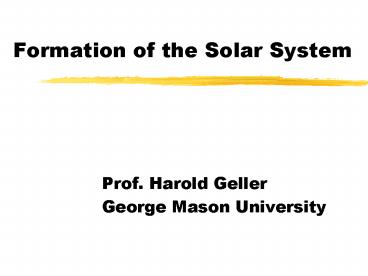Formation of the Solar System PowerPoint PPT Presentation
Title: Formation of the Solar System
1
Formation of the Solar System
- Prof. Harold Geller
- George Mason University
2
Food for thought...
- The grand aim of all science is to cover the
greatest number of empirical facts by logical
deduction from the smallest number of hypotheses
or axioms. - Albert Einstein, 1950
3
What Im Going to Talk About
- Formation of the Solar System
- preview of the big bang theory
- the interstellar medium
- nebular condensation theories
- whats the impetus
- abundance of the chemical elements
- the linear view
- the logarithmic view
4
Questions to Consider
- How did the solar system evolve?
- What are the observational underpinnings?
- Are there other solar systems? (to be discussed
at end of semester) - What evidence is there for other solar systems?
- BEGIN AT THE BEGINNING...
5
Big Bang Summary
6
A Pictorial View
7
Pictorial View Continued
8
HST Pictorial Evidence?
9
HST Pictorial Evidence?
10
Abundance of the Chemical Elements
- At the start of the Stellar Era
- there was about 75-90 hydrogen, 10-25 helium
and 1-2 deuterium - NOTE WELL
- Abundance of the elements is often plotted on a
logarithmic scale - this allows for the different elements to
actually appear on the same scale as hydrogen and
helium - it does show relative differences among higher
atomic weight elements better than linear scale - Abundance of elements on a linear scale is very
different
11
Log Plot of Abundance
12
Another Log View
13
A Linear View of Abundance
14
Another Linear View
15
Other Observations
- Radioactive dating of solar system rocks
- Earth 4 billion years
- Moon 4.5 billion years
- Meteorites 4.6 billion years
- Most orbital and rotation planes confined to
ecliptic plane with counterclockwise motion - Extensive satellite and rings around Jovians
- Planets have more of the heavier elements than
the sun
16
Planetary Summary
17
Other Planet Observations
- Terrestrial planets are closer to sun
- Mercury
- Venus
- Earth
- Mars
- Jovian planets furthest from sun
- Jupiter
- Saturn
- Uranus
- Neptune
18
Some Conclusions
- Planets formed at same time as sun
- Planetary and satellite/ring systems are similar
to remnants of dusty disks such as that seen
about stars being born (e.g. T Tauri stars) - Planet composition dependent upon where it formed
in solar system
19
Nebular Condensation (protoplanet) Model
- Most remnant heat from collapse retained near
center - After sun ignites, remaining dust reaches an
equilibrium temperature - Different densities of the planets are explained
by condensation temperatures - Nebular dust temperature increases to center of
nebula
20
Nebular Condensation Physics
- Energy absorbed per unit area from sun energy
emitted as thermal radiator - Solar Flux Lum (Sun) / 4 x distance2
- Flux emitted constant x T4 Stefan-Boltzmann
- Concluding from above yields
- T constant / distance0.5
21
Nebular Condensation Chemistry
22
Nebular Condensation Summary
- Solid Particles collide, stick together, sink
toward center - Terrestrials -gt rocky
- Jovians -gt rocky core ices light gases
- Coolest, most massive collect H and He
- More collisions -gt heating and differentiating of
interior - Remnants flushed by solar wind
- Evolution of atmospheres
23
What I Talked About
- Preview of the Big Bang theory
- Pause to look at observables
- The Chemical Abundance of Elements
- Pause to realize how it came to be
- Formation of the Solar System
- Nebular Condensation Theory

